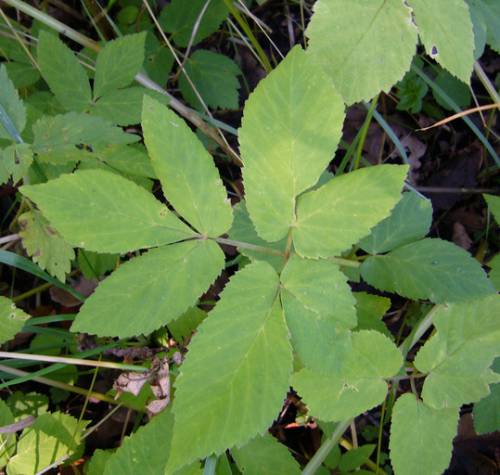Bishop's weed identification and control
Information about the weed of concern bishop’s weed. Bishop’s weed is also known by its scientific name, Aegopodium podagraria.
About this weed
Bishop’s weed is designated as a weed of concern in King County. This means control is not required, but is recommended, and new plantings are discouraged.
Bishop’s weed is known as Aegopodium podagraria and it is in the carrot family. It is also commonly known as goutweed, ground elder, and snow-on-the-mountain.

Why it's a problem
It was brought to North America as an ornamental and is used as a low maintenance ground cover. When it escapes into natural areas, it forms dense, impenetrable patches that displace native plants and inhibit the establishment of native tree seedlings. Highly shade tolerant, it is capable of invading closed-canopy forests. Once established it is difficult to eradicate.
Plant description
Bishop’s weed, also called goutweed, is a creeping, herbaceous perennial (plants that have a 2+ year life cycle) in the carrot family native to Europe and northern Asia. 1.5 to 3 feet tall, often with variegated (white & green) leaf color, it can revert to solid green outside of cultivation.
Small white flowers in umbrella-shaped clusters 2-5 inches across rise above the leaves on tall stalks, usually in June. These clusters grow up to 3 feet tall. The flowering shoots are less common in densely shaded areas.
Leaves are compound (divided into leaflets), upper ones with 3 sets of 3 leaflets on short petioles (leaf stalks), lower ones usually with 9 leaflets and long petioles. Leaflets are toothed, pointed at the tip, and rounded or heart shaped at the base. The ornamental type has bluish green leaves and creamy white edges, while non-ornamental varieties have solid green leaves. Some patches may contain both types.
The plant spreads by fast growing underground roots called rhizomes as well as seeds. The seeds are small and long, similar in size and shape to carrot seeds. They ripen in late summer. The rhizomes are long, white, and branching.
Bishop’s weed is found in old gardens and a variety of other disturbed habitat such as cut forests, abandoned fields, and pastures. It appears to grow best in moist soil and light to moderate shade but is highly shade tolerant and capable of invading closed canopy forests. Seedlings generally need recently disturbed soil and bright light to survive. It does not appear to form a long-lived seed bank.





Be aware of look-alike plants
Flowers from Bishop’s Weed can be mistaken for Wild Carrot (also known as Queen Anne’s Lace). Wild Carrot is a Class C non-regulated weed in King County. Learn more about how to identify Wild Carrot.
When in doubt, take photos and report them on iNaturalist.
What to do if you find it
As a weed of concern, property owners in King County are not required to control bishop’s weed. King County is not tracking infestations. We can provide advice on how to control bishop’s weed but there is no legal requirement to do so. The King County Noxious Weed Control Board encourages property owners to remove bishop’s weed where possible, and to avoid introducing it to new landscapes.
Control is recommended where natural resources are being protected or as part of a stewardship plan. Even a small piece of rhizome can re-sprout into a new plant, so take care to dispose of all plant material carefully and clean your clothing and shoes after going through or working with a patch of bishop’s weed.
Control methods
Prevention is the most effective means of control. Many states have banned sales of bishop’s weed for this reason.
Regardless of the type of management, the patch should be carefully monitored for a couple years to ensure no resprouting. New plants should be dug up and destroyed. Revegetation with native or desirable plants is recommended to help prevent reestablishment. This is especially critical on sites where erosion is a concern or other invasive species are likely to colonize.
We recommend using a combination of methods to control bishop’s weed. In areas with few weeds, it is important to act quickly before they become harder to control. Make a long-term plan as it often takes several years to get rid of most weeds. Start in the least infested areas first and then move into more heavily infested areas.
Cultural control
Depleting the energy reserves can also control the plant. Cut the plants once they are fully leafed out with a mower scythe or weed whacker and then cover the area in plastic. This will have more of an impact if done in the spring soon after the leaves have grown. Waiting until mid- or late summer when the plants already have regained their reserves will be less effective.
Manual control
Carefully dig out plants, removing as much of the rhizomes as possible. Pulled plants can be pilled up and dried out before bagging and disposing.
Chemical control
Stay safe when using herbicide:
- Always read the label before use.
- Wear a long-sleeved shirt, long pants, shoes, and eye protection.
- Follow state and local regulations.
A systemic herbicide such as glyphosate can be effective against bishop’s weed. Killing the roots and rhizomes is a critical part of control.
For more information or a site-specific control recommendation in King County, contact the noxious weed program. For information in other counties in Washington state, contact your local weed board or your local cooperative extension office.
Disposal instructions
Bag and dispose of all plant debris as plant fragments readily resprout. It is most commonly spread through plantings and accidental rhizome spreading by dumping garden waste.
Noxious Weed Disposal - Washington State Noxious Weed Control Board

 Translate
Translate